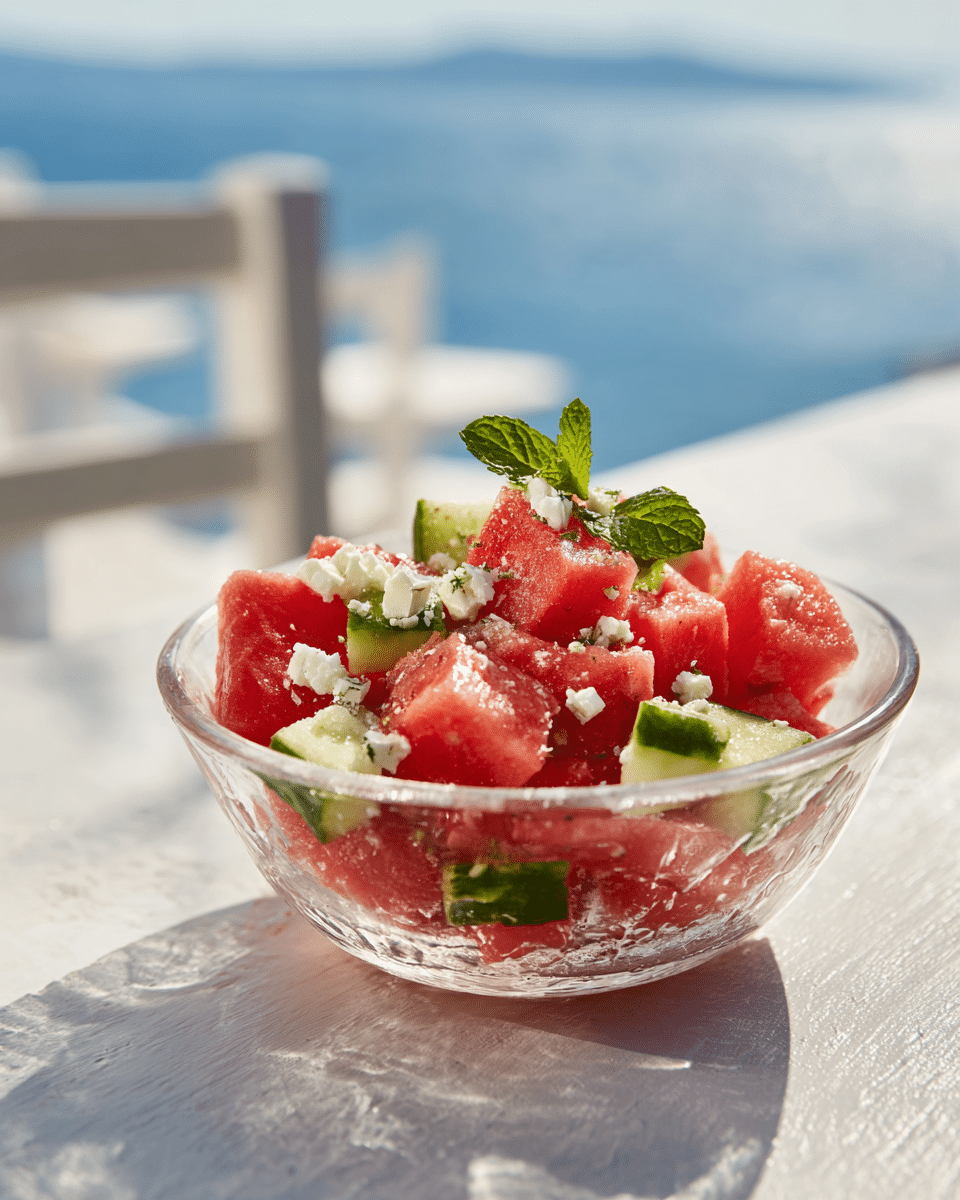This Watermelon Feta Salad is a celebration of vibrant summer flavors. Juicy, sweet watermelon cubes are paired with creamy, tangy feta cheese, fresh mint, and a touch of zesty lime. It’s a sweet and salty side dish that offers a cooling contrast to hot weather meals. Perfect for picnics, barbecues, or a light lunch, this salad balances hydrating fruit with bold flavors, offering a burst of freshness in every bite.
FULL RECIPE
Ingredients
- 4 cups seedless watermelon, cut into 1-inch cubes
- 1 cup cucumber, thinly sliced or diced
- ¾ cup feta cheese, crumbled
- ¼ cup fresh mint leaves, chopped
- 2 tablespoons red onion, thinly sliced (optional)
- 2 tablespoons fresh lime juice
- 1 tablespoon extra virgin olive oil
- Salt, to taste
- Freshly ground black pepper, to taste
Directions
- In a large mixing bowl, combine the watermelon cubes, cucumber slices, and red onion (if using).
- Gently fold in the crumbled feta cheese and chopped mint leaves.
- In a small bowl, whisk together the lime juice, olive oil, salt, and pepper to create the dressing.
- Pour the dressing over the salad ingredients and gently toss to coat everything evenly.
- Chill in the refrigerator for about 15–20 minutes before serving to enhance the flavors.
- Garnish with extra mint leaves or a few more crumbles of feta before serving, if desired.
Nutrition Facts
- Calories: 135
- Protein: 4g
- Total Fat: 8g
- Saturated Fat: 3g
- Cholesterol: 15mg
- Carbohydrates: 13g
- Dietary Fiber: 1g
- Sugars: 10g
- Sodium: 260mg
- Vitamin C: 18% DV
- Calcium: 10% DV
The Origins and Popularity of Watermelon Feta Salad
Watermelon Feta Salad has become a beloved dish in many parts of the world, especially in warm climates where fresh, hydrating ingredients are prized. Its roots can be traced to Mediterranean cuisine, where the combination of sweet fruits and salty cheeses is common. The salad’s appeal lies in its simple yet vibrant mix of contrasting flavors and textures, making it a popular choice for summer gatherings, outdoor parties, and light meals. Over time, it has evolved into a trendy, refreshing salad that chefs and home cooks alike enjoy for its balance of sweetness, saltiness, and freshness.
Health Benefits of Watermelon
Watermelon is not only delicious but also packed with nutrients that contribute to overall health. It is rich in vitamins A and C, both of which are powerful antioxidants that support skin health and immune function. Watermelon’s high water content—about 92%—makes it excellent for hydration, particularly during hot weather. Additionally, watermelon contains lycopene, a compound linked to reduced risk of certain cancers and heart disease. Its natural sugars provide a sweet energy boost without the heaviness of processed sweets.
Nutritional Value of Feta Cheese
Feta cheese, a staple in Mediterranean diets, adds a creamy texture and tangy flavor to the salad while also contributing valuable nutrients. It is a good source of calcium and protein, essential for bone health and muscle maintenance. Though it is higher in sodium than some other cheeses, feta’s fat content is moderate, and it contains beneficial probiotics that support gut health. Using feta in moderation allows one to enjoy its rich taste without overwhelming the dish or compromising nutritional balance.
Role of Fresh Herbs in Enhancing Flavor
Fresh mint leaves are integral to the watermelon feta salad’s refreshing profile. Mint provides a cool, aromatic flavor that contrasts beautifully with the sweetness of watermelon and the saltiness of feta. Beyond flavor, mint offers digestive benefits and a slight cooling effect that enhances the salad’s appeal during hot weather. Some variations include basil or cilantro for different herbal notes, but mint remains the classic choice for this salad.
Variations and Customizations
One of the best aspects of watermelon feta salad is its versatility. While the traditional recipe features watermelon, feta, mint, cucumber, and a citrus dressing, many variations exist. Adding ingredients like arugula or baby spinach can introduce a peppery or earthy flavor and increase the salad’s nutritional profile. Nuts such as pistachios or toasted almonds add crunch and healthy fats. For a more savory twist, some recipes incorporate olives or a drizzle of balsamic glaze. These variations allow the salad to adapt to different tastes and occasions.
Best Dressings to Complement the Salad
The dressing in watermelon feta salad typically combines lime juice and olive oil, balancing acidity with richness. Lime juice brightens the salad and enhances the sweetness of the watermelon, while olive oil adds smoothness and depth. Some recipes call for a touch of honey or a sprinkle of chili flakes to add complexity. The dressing should be light to preserve the freshness of the ingredients, making olive oil and citrus juices the ideal choices. Experimenting with lemon or orange juice can also offer delightful nuances.
Serving Suggestions and Pairings
Watermelon feta salad pairs wonderfully with a variety of main dishes, particularly those suited for summer. It serves as a perfect side for grilled meats such as chicken, lamb, or fish, as the salad’s acidity cuts through rich, smoky flavors. It can also accompany vegetarian dishes like quinoa bowls or grain salads to add freshness. For casual gatherings, this salad works well as part of a mezze platter alongside hummus, pita, and roasted vegetables. Serving it chilled enhances its refreshing quality and elevates any meal.
Storage and Shelf Life
Due to its high water content, watermelon feta salad is best enjoyed fresh. When stored, it should be kept in an airtight container in the refrigerator and consumed within 1 to 2 days for optimal texture and flavor. The watermelon can release juice over time, which may dilute the dressing and make the salad soggy. To maintain freshness, it’s advisable to store the dressing separately and combine just before serving. Proper storage ensures the ingredients retain their crunch and vibrancy.
Tips for Selecting Ingredients
Choosing ripe watermelon is key to a successful salad. Look for melons that feel heavy for their size, have a deep, uniform color, and produce a hollow sound when tapped. Seedless varieties make preparation easier and more pleasant. For feta, opt for authentic Greek feta if possible, as it tends to have a creamier texture and a balanced salty flavor. Fresh herbs should be vibrant green without wilting or browning. Selecting quality ingredients directly impacts the salad’s final taste and presentation.
Cultural Significance and Modern Adaptations
While rooted in Mediterranean culinary traditions, watermelon feta salad has taken on new life in contemporary cuisine worldwide. It reflects a broader trend toward fresh, health-conscious eating with an emphasis on simple, natural ingredients. Chefs have embraced the salad by adding unique twists such as grilled watermelon slices or infused oils. Social media has helped popularize it as a visually appealing dish that is both easy to prepare and packed with flavor. Its widespread appeal continues to grow, symbolizing summer’s bounty and the joy of seasonal cooking.
Conclusion
Watermelon Feta Salad is more than just a dish; it’s an experience of contrasting flavors and textures that come together to refresh and delight. From its nutritious ingredients to its versatile nature and cultural richness, this salad offers a perfect balance of sweetness, saltiness, and freshness. Whether served as a side or a light meal, it brings brightness to any table and embodies the spirit of summer dining.






